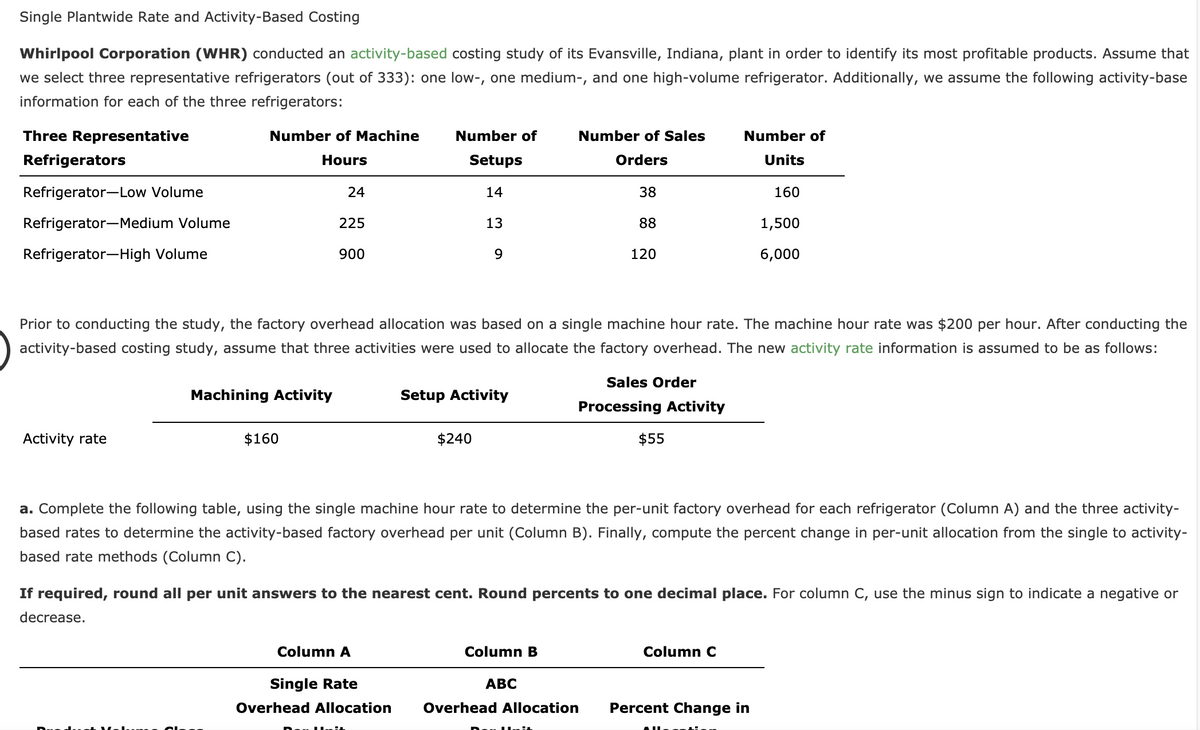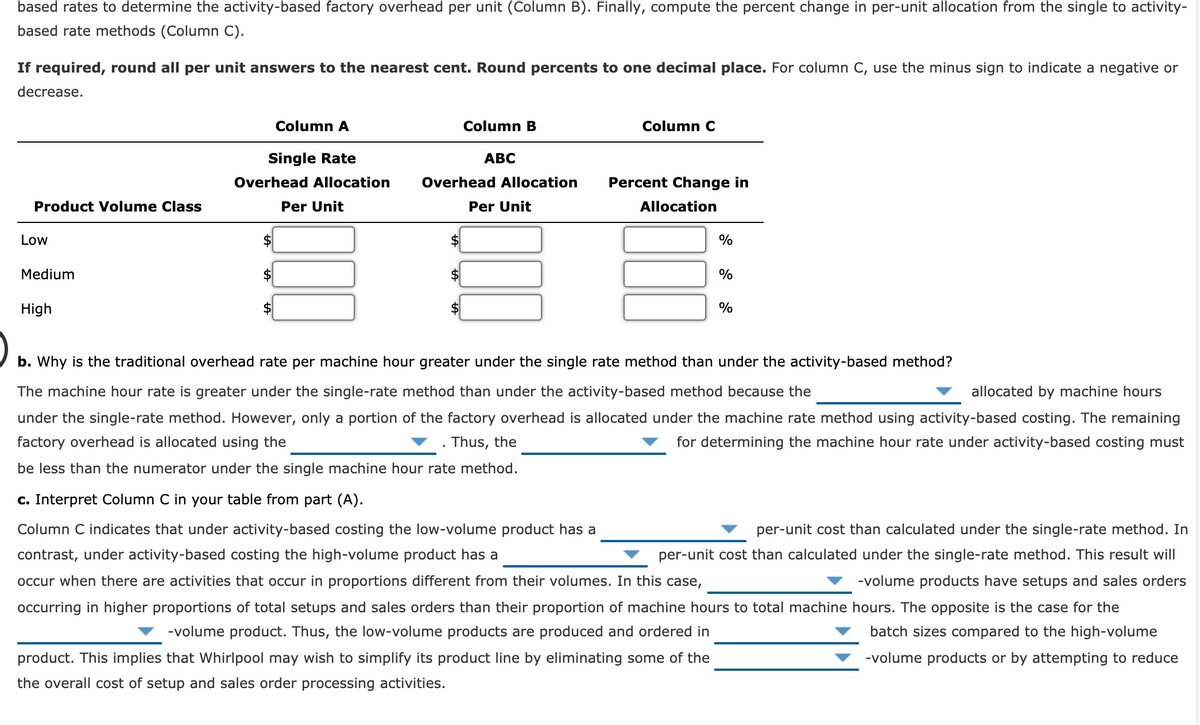Refrigerator-High Volume 900 9 120 6,000 Prior to conducting the study, the factory overhead allocation was based on a single machine hour rate. The machine hour rate was $200 per hour. After conducting the activity-based costing study, assume that three activities were used to allocate the factory overhead. The new activity rate information is assumed to be as follows: Sales Order Machining Activity Setup Activity Processing Activity Activity rate $160 $240 $55 a. Complete the following table, using the single machine hour rate to determine the per-unit factory overhead for each refrigerator (Column A) and the three activity- based rates to determine the activity-based factory overhead per unit (Column B). Finally, compute the percent change in per-unit allocation from the single to activity- based rate methods (Column C). If required, round all per unit answers to the nearest cent. Round percents to one decimal place. For column C, use the minus sign to indicate a negative or
Refrigerator-High Volume 900 9 120 6,000 Prior to conducting the study, the factory overhead allocation was based on a single machine hour rate. The machine hour rate was $200 per hour. After conducting the activity-based costing study, assume that three activities were used to allocate the factory overhead. The new activity rate information is assumed to be as follows: Sales Order Machining Activity Setup Activity Processing Activity Activity rate $160 $240 $55 a. Complete the following table, using the single machine hour rate to determine the per-unit factory overhead for each refrigerator (Column A) and the three activity- based rates to determine the activity-based factory overhead per unit (Column B). Finally, compute the percent change in per-unit allocation from the single to activity- based rate methods (Column C). If required, round all per unit answers to the nearest cent. Round percents to one decimal place. For column C, use the minus sign to indicate a negative or
Managerial Accounting
15th Edition
ISBN:9781337912020
Author:Carl Warren, Ph.d. Cma William B. Tayler
Publisher:Carl Warren, Ph.d. Cma William B. Tayler
Chapter4: Activity-based Costing
Section: Chapter Questions
Problem 16E
Related questions
Question

Transcribed Image Text:Single Plantwide Rate and Activity-Based Costing
Whirlpool Corporation (WHR) conducted an activity-based costing study of its Evansville, Indiana, plant in order to identify its most profitable products. Assume that
we select three representative refrigerators (out of 333): one low-, one medium-, and one high-volume refrigerator. Additionally, we assume the following activity-base
information for each of the three refrigerators:
Three Representative
Number of Machine
Number of
Number of Sales
Number of
Refrigerators
Hours
Setups
Orders
Units
Refrigerator-Low Volume
24
14
38
160
Refrigerator-Medium Volume
225
13
88
1,500
Refrigerator-High Volume
900
120
6,000
Prior to conducting the study, the factory overhead allocation was based on a single machine hour rate. The machine hour rate was $200 per hour. After conducting the
activity-based costing study, assume that three activities were used to allocate the factory overhead. The new activity rate information is assumed to be as follows:
Sales Order
Machining Activity
Setup Activity
Processing Activity
Activity rate
$160
$240
$55
a. Complete the following table, using the single machine hour rate to determine the per-unit factory overhead for each refrigerator (Column A) and the three activity-
based rates to determine the activity-based factory overhead per unit (Column B). Finally, compute the percent change in per-unit allocation from the single to activity-
based rate methods (Column C).
If required, round all per unit answers to the nearest cent. Round percents to one decimal place. For column C, use the minus sign to indicate a negative or
decrease.
Column A
Column B
Column C
Single Rate
АВС
Overhead Allocation
Overhead Allocation
Percent Change in

Transcribed Image Text:based rates to determine the activity-based factory overhead per unit (Column B). Finally, compute the percent change in per-unit allocation from the single to activity-
based rate methods (Column C).
If required, round all per unit answers to the nearest cent. Round percents to one decimal place. For column C, use the minus sign to indicate a negative or
decrease.
Column A
Column B
Column C
Single Rate
АВС
Overhead Allocation
Overhead Allocation
Percent Change in
Product Volume Class
Per Unit
Per Unit
Allocation
Low
$
$
%
Medium
$
%
High
2$
%
b. Why is the traditional overhead rate per machine hour greater under the single rate method than under the activity-based method?
The machine hour rate is greater under the single-rate method than under the activity-based method because the
allocated by machine hours
under the single-rate method. However, only a portion of the factory overhead is allocated under the machine rate method using activity-based costing. The remaining
factory overhead is allocated using the
Thus, the
for determining the machine hour rate under activity-based costing must
be less than the numerator under the single machine hour rate method.
c. Interpret Column C in your table from part (A).
Column C indicates that under activity-based costing the low-volume product has a
per-unit cost than calculated under the single-rate method. In
contrast, under activity-based costing the high-volume product has a
per-unit cost than calculated under the single-rate method. This result will
occur when there are activities that occur in proportions different from their volumes. In this case,
-volume products have setups and sales orders
occurring in higher proportions of total setups and sales orders than their proportion of machine hours to total machine hours. The opposite is the case for the
-volume product. Thus, the low-volume products are produced and ordered in
batch sizes compared to the high-volume
product. This implies that Whirlpool may wish to simplify its product line by eliminating some of the
-volume products or by attempting to reduce
the overall cost of setup and sales order processing activities.
Expert Solution
This question has been solved!
Explore an expertly crafted, step-by-step solution for a thorough understanding of key concepts.
This is a popular solution!
Trending now
This is a popular solution!
Step by step
Solved in 4 steps

Recommended textbooks for you

Managerial Accounting
Accounting
ISBN:
9781337912020
Author:
Carl Warren, Ph.d. Cma William B. Tayler
Publisher:
South-Western College Pub

Financial And Managerial Accounting
Accounting
ISBN:
9781337902663
Author:
WARREN, Carl S.
Publisher:
Cengage Learning,

Cornerstones of Cost Management (Cornerstones Ser…
Accounting
ISBN:
9781305970663
Author:
Don R. Hansen, Maryanne M. Mowen
Publisher:
Cengage Learning

Managerial Accounting
Accounting
ISBN:
9781337912020
Author:
Carl Warren, Ph.d. Cma William B. Tayler
Publisher:
South-Western College Pub

Financial And Managerial Accounting
Accounting
ISBN:
9781337902663
Author:
WARREN, Carl S.
Publisher:
Cengage Learning,

Cornerstones of Cost Management (Cornerstones Ser…
Accounting
ISBN:
9781305970663
Author:
Don R. Hansen, Maryanne M. Mowen
Publisher:
Cengage Learning

Managerial Accounting: The Cornerstone of Busines…
Accounting
ISBN:
9781337115773
Author:
Maryanne M. Mowen, Don R. Hansen, Dan L. Heitger
Publisher:
Cengage Learning

Principles of Accounting Volume 2
Accounting
ISBN:
9781947172609
Author:
OpenStax
Publisher:
OpenStax College

Principles of Cost Accounting
Accounting
ISBN:
9781305087408
Author:
Edward J. Vanderbeck, Maria R. Mitchell
Publisher:
Cengage Learning